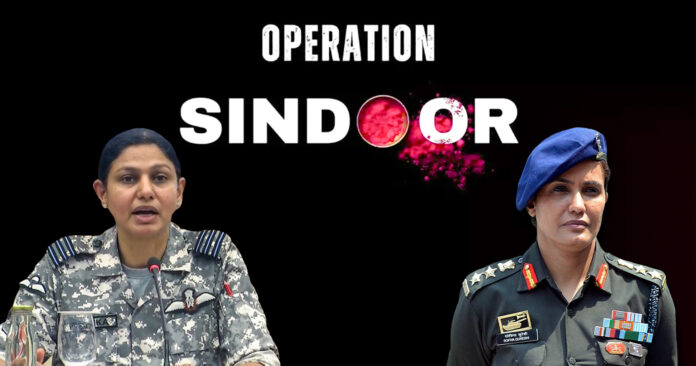In a nation where symbols speak louder than policy and sentiment often overrules substance, feminism has found itself conscripted into the ranks of political theatre. Yes, this is India’s new political narrative, and it just got evident in their recent military offensive branded as “Operation Sindoor”, a name cloaked in the language of womanhood, yet steeped in patriarchal undertones.
Nowhere is this more glaring than in the case of Operation Sindoor, a military campaign named after the red powder symbolising married Hindu women. The state did not merely promise justice or retribution — it turned to the figure of the mourning widow, the “veer patni” (brave wife), as its emotional anchor. Himanshi Narwal, whose husband was among the martyrs, became the poster child of this operation. Images of her crying beside her husband’s dead body were turned into Ghibli trend and was weaponised for by slogans of vengeance and national pride. Her calls for peace were soon drowned out by political messaging. The state had found its perfect emblem: a woman whose pain could be neatly weaponised.
India’s New Political Narrative: Feminism
Operation Sindoor was less about counter-terrorism and more about performance — a pageant of patriotism starring the woman as martyr-by-association. In this narrative, her identity was not her own; she became a brand for the nationalist cause, a propaganda.
This phenomenon is not unique to India. It fits into a global pattern often referred to as “embedded feminism” — where feminist rhetoric is incorporated into state narratives in a way that reinforces, rather than dismantles, existing power structures. We see this when nations tout women in uniform while ignoring widespread sexual violence in the military. We see it when governments speak of “saving” oppressed women in enemy countries to justify war, while remaining silent about injustices at home.
In India, the state has found a convenient tool in feminist aesthetics. But these aesthetics are hollow. India is a nation that struggles to ensure basic safety, employment, and autonomy for its women. It has no business peddling feminism as a justification for its military operations. The same government that remains silent on marital rape and routinely undercuts women’s rights in law cannot credibly claim to act in women’s name when it suits its geopolitical goals.
These pre-war (and post-war) patriarchal conditions lead Enloe to observe that “women’s wars are not men’s wars” because women’s wars are shaped by “gender politics during patriarchal peacetime.” Sexual violence, gender-based violence, underemployment, unpaid and underpaid work, and limited reproductive rights are women’s wars.
The Silencing of Dissent
Perhaps the most chilling aspect of this narrative is the way it flattens and silences dissent. Himanshi Narwal initially called for peace — a perfectly human response. But the machinery of nationalism found this inconvenient. In the days that followed, her stance “evolved” to one that aligned neatly with state sentiment. Whether this shift was voluntary or the result of coercive public pressure is beside the point. The real tragedy is that she was never allowed to simply grieve. Her pain had to be productive. Her sorrow had to serve a purpose.
This is the dark underbelly of performative patriotism masquerading as feminism. Women are allowed space in the national imagination only when they echo the sanctioned script. Step outside it, and they are branded ungrateful, anti-national, or worse.
Pink Washing of War
In another viral image, Colonel Sofia Qureshi and Wing Commander Vyomika Singh sat alongside Indian Foreign Secretary Vikram Misri to lead the Operation Sindoor media briefing. This move was cleverly curated to lend a feminist face to the lingering India-Pakistan conflict.
Indian media reported this as a historical milestone for Indian women’s representation. However, this curated image of communal and religious unity has been criticised as being mere “secular tokenism” that hides Indian Muslims’ and Kashmiris’ reality of discrimination and violence. The name also misrepresented women like Qureshi and Singh. The name centres on women’s role as wives in traditional marriages. The professional work of women like Colonel Qureshi and Wing Commander Singh only becomes visible when they step in to protect the sindoor.
This valorisation of militarism as feminism also overlooks the fact that Indian women are significantly underrepresented in the Indian military.
The image also created women heroes of the war to ramp up support for the war. One headline read: “The terrorists ‘spared’ women, but India’s women will not spare them.” Unsurprisingly then, many Indian celebrities with feminist reputations shared the image of Qureshi and Singh’s media briefing to express their support and celebration. One viral image on X portrayed Qureshi and Singh’s portraits in military uniform alongside a topi-burqa-clad woman to compare feminist India against regressive Pakistan, to show that Indian women are ‘better’ than Pakistani women.
But the fact remains that both Pakistani and Indian women fight similar fights in pre-war or peacetime conditions. With or without a burqa.
The Appropriation of Feminism is Not Progress
When feminism is turned into state propaganda, it loses its purpose. It ceases to question power and begins to serve it. It stops being about choice and becomes about conformity. Real feminism: the messy, disruptive, justice-seeking kind is sidelined in favour of a cleaner, shinier version that plays well on state-sponsored billboards and 9 PM news debates.
The appropriation of feminism in India’s political narrative is not a sign of progress; it is a siren of caution. It shows us that even the language of liberation can be turned into an instrument of control. It also shows that “feminising” war does not make war any better. A bomb dropped by a woman on civilians is still a war crime and it always will be.
Stay tuned to Brandsynario for latest news and updates






































